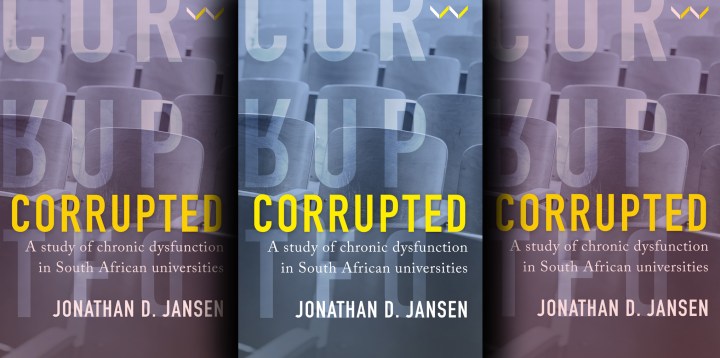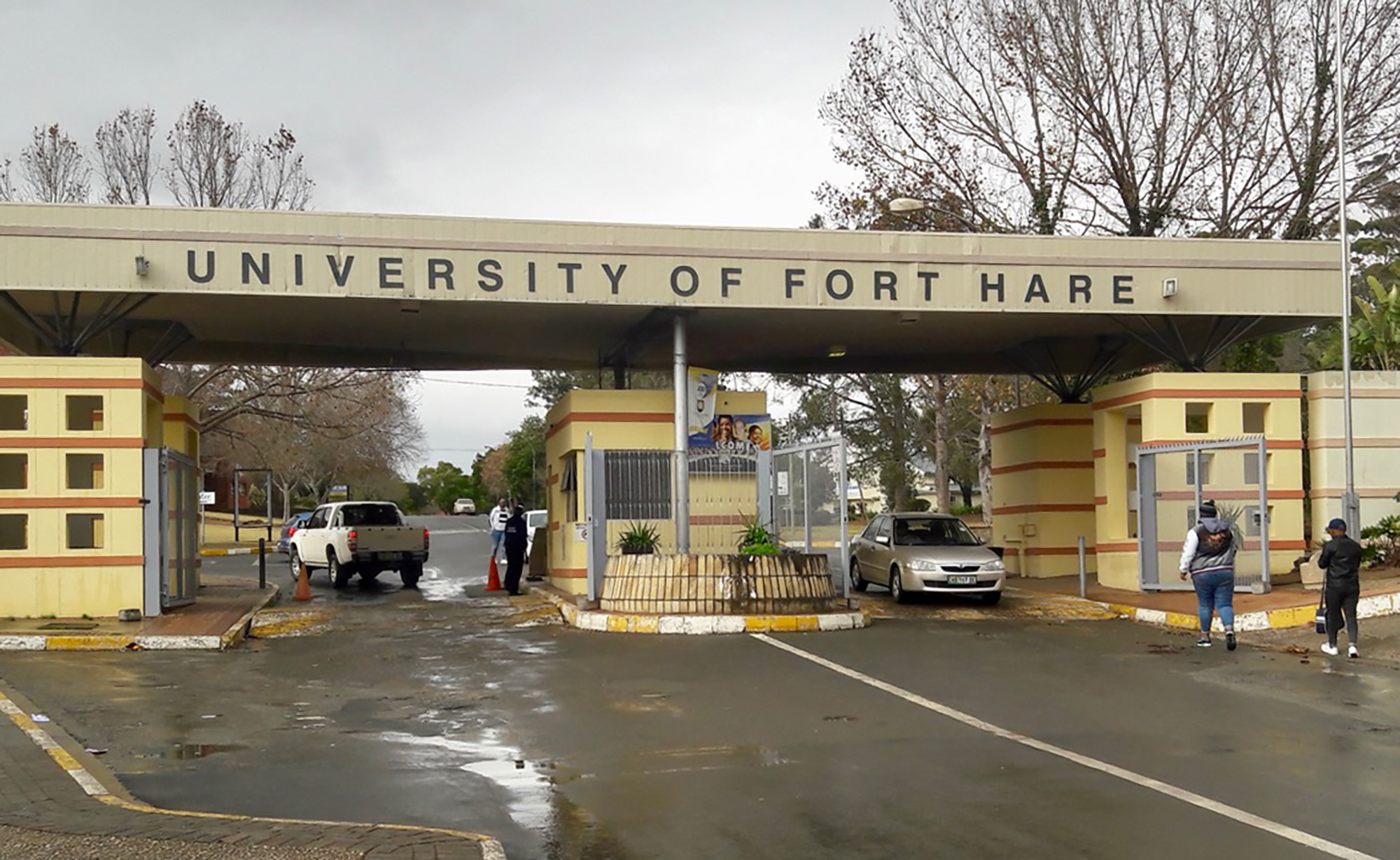BOOK EXTRACT
‘Corrupted’ – a study of chronic dysfunction in South African universities

When students, staff, managers and governors come to the university primarily to gain access to its resources, it ceases to be a university. When criminals are members of councils or embedded in the administration and management of universities, then higher education institutions begin to resemble the corrupt state-owned enterprises outside campus. ‘Corrupted’ is published by Wits University Press.
The University of Fort Hare (UFH) did more than most universities in the post-apartheid era to honour the flat stakeholder model of democracy in which every constituency would be represented at the governance table. This was particularly true when it came to the representatives of Eastern Cape municipalities on the UFH Council. The 2010 Institutional Statute loaded the council with municipal and local government officials.
The dominating presence of local politicians on the council, representing in the main the ruling party at the provincial and municipal levels, turned out to be a recipe for disaster. These leaders came from municipalities that were seriously mismanaged, receiving qualified audits and worse, because of governance malfunction in areas such as risk management, internal audit, and material misstatements in financial statements. If competence and a good track record were supposed to be a factor in the selection for council members, these officials represented the exact opposite.
As one vice-chancellor explained, “the turbulence is caused by their business interests. I have seen them destroy government departments, they have destroyed SOE’s [state-owned enterprises], they sucked up all the juice in municipalities; the only institution that remains where there is a massive in-flow of money because of infrastructure [funds] is the university.”

The entrance to the University of Fort Hare. (Photo: GroudUp / Chris Gilili)
In fact, the municipality is so dysfunctional, notes this vice-chancellor, that “the university does waterworks and sewerage disposal for the town of Alice because, without that, Alice is not functional at all”.
This flat model of stakeholder democracy would be costly for an already vulnerable university like the UFH, so in its revised statute of 10 years later, the municipal representation was dropped from council membership in favour of a lean structure with only two government-related appointees.
The trimmed-down membership arrangements did not, however, stop a continued run on institutional resources from those on and off the councils of dysfunctional universities. University leaders found themselves fighting on two fronts: “the rogues that were embedded in the structures” and “those forces standing at the gates wanting a piece of the action”. How did the internal and external interests vying for university resources interact to gain access to university resources?
First, they used the students. In every one of the dysfunctional universities there were reports of students being paid to influence council and management decisions and, if they failed, to create havoc on campus and pile pressure on decision-makers to enable access to vital resources.
Student leaders would ally with unions and form a powerful bloc within council that would influence important outcomes, such as the ejection of a vice-chancellor who had closed the taps on corruption. In return, student leaders would receive extraordinary benefits from rogue leaders in the university such as cash payments, travel to conferences, access to rental or university cars, and ample funding for student “bashes”.
Read in Daily Maverick: We condemn the assassination attempt on the vice-chancellor of the University of Fort Hare
Read in Daily Maverick: “Dark days: Accusations of capture and governance instability rock UCT”
Second, they used proxies. What this means is that while a council member might sit in the governance structure and declare on the record that they had no interests in the business of the university, in reality, there were indirect circuits for the command and flow of institutional resources.
One vice-chancellor observed that “external council members would be sitting in the boardroom and WhatsApp throughout the meeting… because the taps are running dry every day.”
Another vice-chancellor remembers that he could “never figure out why certain bidders for university business would come in exactly on or around budget without anyone outside these council meetings supposedly knowing the planned allocation of resources”.
One of the most egregious of such internal-external corruption incidents involved a UFH professor who irregularly registered the premier of the Eastern Cape for master’s studies and the provincial health MEC for an honours degree. The university later laid charges against the professor for defrauding it of about R5-million for “unauthorised academic work and programmes for the Eastern Cape legislature and municipal authorities without the knowledge and consent of the university”.
With the openly anti-corruption stance of the vice-chancellor, it came as no surprise that the same premier would do something highly unusual for a political head of a province – launch frontal attacks on the university’s vice-chancellor over issues like student suicides.
Through the governance structure, corrupt council members now had a firm grip on governance over a university’s resources. This meant that any threat to those material interests would be met with force, and in every dysfunctional university there are horror stories of how efforts to bring stability could turn deadly. One senior manager at a troubled university recalls that “there was a lot of skulduggery and people lost their lives in the process and every time someone lost their life, a story would come out as to their probable involvement”.
Visit Daily Maverick’s home page for more news, analysis and investigations
At this same university, students and unions were on the tender committees, so that “governance oversight bordered on interference when it came to tenders”. In the process, the necessary boundary between governance and management was often breached, as in the case of an external member of council who “would go past the vice-chancellor and speak to middle managers in the finance department, and late on a Friday, would demand to look at the contracts”. In another instance, a member of council who had a security business competed for the security tender and got it.
Read in Daily Maverick: “We need to protect whistle-blowers at institutions of higher learning to stop the rot of corruption”
Under these conditions, at almost every one of the dysfunctional universities, the vice-chancellors, and sometimes also their deputies and other senior executives, all travel with armed security. The outside administrators who were brought in to rescue these institutions would also be required to have security and not to travel without guards. This is the real “securitisation” that has crept up on universities, leading to a dramatic shift in campus life largely invisible to those living in the urban centres of South Africa. Ironically, it was the securitisation of universities that would often spawn another target for corruption – tenders for security services.
It would be naïve to think that the ministerial appointees to councils (up to five of them) were all ethically astute persons who always acted in the best interests of the university. While many such appointees were credible and ethical persons, there is abundant evidence in this study of individual appointees who themselves tried to eat into the institutional resources of some of the struggling universities.

Professor Jonathan Jansen is author of a new book on the state of SA’s universities, Corrupted. Photo: courtesy of UOFS.
One vice-chancellor said he was shocked that it was a ministerial appointee who pressed council that members be remunerated for their meeting obligations. Sometimes, the ministerial representatives were the backbone of strong governance in a failing institution; at other times, they were ineffective, at best, or part of the problem, at worst. From time to time, a minister would recall and replace his or her team of appointees out of frustration with their ineffectiveness at resolving problems in council.
What are the consequences of this embedded criminality in institutional cultures for South African higher education and, in particular, among the dysfunctional universities?
In short, the focus of so much of the university’s attention on its material resources – to grab them or to protect them from being grabbed – would lead to a massive distraction from its academic mandate. In other words, the academic agenda of an institution would become completely distorted in corrupt and dysfunctional universities because leadership attention was redirected to nonacademic matters. The narrow focus on resources meant that academic matters remained secondary to the agendas of management, senate, and council. A council member at one dysfunctional university resigned precisely because of the distortion of the academic agenda; in her words, “an hour or two would be spent on discussing compensation for council members!” These council members were simply uninterested in the academic project.
When students, staff, managers and governors come to the university primarily to gain access to its resources, it ceases to be a university. When criminals are members of councils or embedded in the administration and management of universities, then higher education institutions begin to resemble the corrupt state-owned enterprises outside campus. That is why, throughout the interviews for this research, unflattering parallels were drawn by senior academic leaders between public universities and state parastatals or welfare bodies.
What happens when criminality seems to be embedded in the institutional fabric of a South African university? When senior leaders in higher education talk about universities as being “captured”? Can these universities be rescued and set on track to reclaim their academic mandate?
Or were these dysfunctional institutions, in the words of one assessor, never universities to begin with? DM
Jonathan Jansen is Distinguished Professor of Education at Stellenbosch University and President of the Academy of Science of South Africa. His most recent books include “The Decolonisation of Knowledge” (Cambridge University Press, with Cyrill Walters) and “Decolonisation in Universities: The Politics of Curriculum” (Wits University Press: 2019).
















 Become an Insider
Become an Insider
The ANC has unleashed the beast – we now have systemic failure with no easy route back.
The poor get poorer and they do not care!